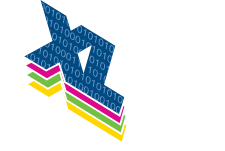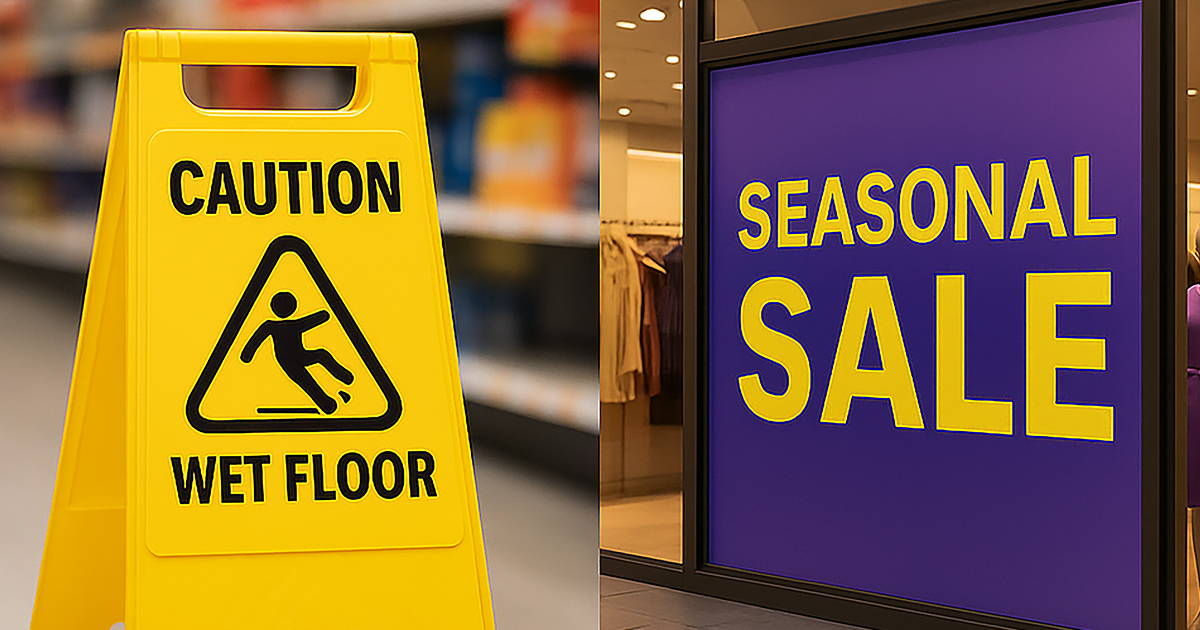The Science Behind Color Response
Research widely cited in marketing psychology suggests that people make a subconscious judgment about a product within 90 seconds of viewing it — and that a large portion of this impression is based on color. In large format applications, where visual interaction is often brief, this insight is especially relevant.
A 2009 study from the University of British Columbia, published in Science, found that red environments boosted attention to detail, while blue environments fostered creativity and openness. These findings offer practical implications: use red to direct focus and urgency, and blue to encourage trust and calm.
Color Performance by Industry
Retail and Commercial Environments
According to insights from the Color Marketing Group and retail branding studies, color can significantly influence purchasing behavior. Red, for instance, is often used in sale graphics to create urgency and drive impulse purchases, while blue is associated with reliability — making it popular among financial institutions and healthcare providers.
However, prolonged use of red can also raise anxiety levels, so its use should be strategic and limited to specific messaging such as flash sales or urgent calls to action.
Sports and Entertainment Venues
Color also plays a powerful role in fan engagement and merchandise sales. Research in sports branding shows that prominently featuring team colors in signage and promotional graphics can deepen emotional connections and enhance perceived team loyalty. In high-traffic stadium settings, high-contrast color combinations improve readability under challenging lighting conditions — a critical factor for wayfinding and sponsor visibility.
The Distance Factor in Large Format Design
Viewing distance plays a major role in how color performs. Research in visual perception confirms that certain color combinations — such as black and yellow — maintain legibility and vibrancy at much greater distances than more subtle pairings. This is why these combinations are frequently used in emergency signage.
For large format applications like billboards or wayfinding systems, designers must account for how colors shift in tone, contrast, and saturation when viewed from afar. A palette that looks vibrant on screen may lose its impact in real-world scale and lighting conditions.
Cultural Considerations in Color Choice
Color meanings can vary widely across cultures. While red often signifies urgency or passion in Western cultures, it symbolizes luck and prosperity in many Asian markets. Research published in the International Journal of Design has shown that advertising campaigns using culturally resonant color schemes significantly outperform those relying on standardized global palettes — boosting brand perception and emotional engagement.
For large format campaigns targeting diverse audiences or international markets, it’s essential to test and tailor color usage to cultural expectations.
Memory and Color Retention
Color doesn’t just attract attention — it also helps us remember. Multiple studies in marketing and cognitive science show that color enhances brand recognition. While one frequently cited marketing study suggests color may improve recall by up to 80%, what’s clear from validated research is that high-contrast and consistent use of color strengthens memory encoding.
Contrasting combinations like blue and orange or purple and yellow tend to increase visual distinctiveness. However, too many primary colors can create visual noise — designers should aim for clarity and simplicity to maximize long-term recall.
Practical Applications for Large Format Success
These insights translate directly into better large format design:
- Use high contrast for legibility and attention.
- Leverage red for action-oriented graphics; use blue for trust-building messaging.
- Maintain color consistency across campaigns to enhance recall.
- Tailor colors to cultural context when addressing diverse audiences.
- Test real-world visibility at scale — not just on screen.
Ultimately, the best large format graphics aren’t just noticed — they’re remembered and acted upon. By grounding design decisions in both color psychology and performance data, businesses can create visuals that truly resonate and convert.
Bringing Color Psychology to Life
At XL Digital, we understand that color psychology isn’t just theory — it’s a practical tool for creating graphics that perform. Our advanced color management systems ensure that the psychological impact you design is exactly what gets delivered, maintaining color accuracy and vibrancy across all materials and viewing conditions.
From initial color consultation to final production, our 24+ years of large format experience means we understand how colors behave at scale, under different lighting conditions, and across various substrates. When your project’s success depends on getting color psychology right, XL Digital delivers the precision and consistency that turns color theory into measurable results.
Ready to harness the power of color psychology in your next large format project? Contact our team to discover how strategic color choices can transform your graphics from simply visible to truly influential.

